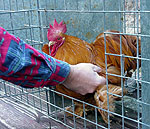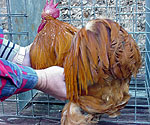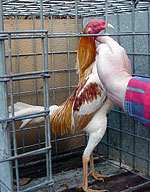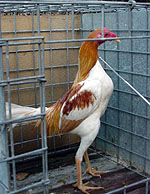Once the birds are selected, it is
important to care for them correctly to minimise damage to condition and plumage.
At this time, the housing for your birds
must be carefully prepared. Place the birds in a clean shed that is dry and free from
drafts. Cover the floor with deep, clean wood shavings. I use coarse pine shavings as
these do not stain white feathers and remain dry and loose for maximum absorbency of
wastes. This is particularly important when preparing birds like Pekins, that have
feathered feet. Make sure that the water containers are of a type that will minimise
spillage. At this time, feed is provided in containers where the birds do not have to
scratch to find it. This helps in keeping legs and feet clean.
Now the birds are settled in their new
accommodation, they must become accustomed to being handled. Many splendid birds have
lost, simply because they were not trained properly and did not display themselves to best
advantage. Handle each bird once or twice daily for at least two weeks. During this period
the birds should be introduced to show pens. These are small cages which are approximately
the same dimensions and construction of the cages found at the show. Initially, it may be
easier to train the birds at night when they are generally more docile, so the training
cages would be best set up in a draft-free, well lit shed or garage. Flightier breeds such
as Hamburghs and Leghorns tend to need more handling and cage training than more docile
ones and this must be taken into consideration when planning your training program.
Small pieces of bread or other delicacies
may be fed to the birds until they are confident enough to take these directly from your
hand. Timid birds never show themselves well and tend to crouch at the back of the show
pen and poultry shows are generally busy, noisy places. An important part of training your
birds involves other family members and friends. Have them view your birds regularly
during the training period so they become used to strangers and noise.
There is a real danger at this time for
feathers to be broken or damaged so it is important to learn the correct procedure for
removing birds from the show cages. This following is the best way to catch and remove
birds from small cages.
Reach into cage and turn the bird so its
head faces the door (with flighty birds ensure they cannot fly out the door).
Place your right thumb on the bird's back
just above the wing and grasp the left wing and thigh together. Turn your wrist slightly
so the bird's weight rests along your forearm. Obviously most birds will struggle to some
degree, but once you have pinioned the wing and thigh, the bird is almost helpless. This
method works well for birds (and people) of all sizes.
Gently guide the bird toward the door
head-first.
Place the fingers of your left hand under
the breast with the thumb along the side of the right wing to prevent it flapping
unnecessarily. You can now easily remove bird from the cage.
Once free of the cage, the bird will be
resting along your right forearm. Place the right leg between your first and middle
fingers of your right hand and grip both legs. Your first finger will be between the
bird's legs (for large birds, sometimes 2 fingers are needed to be placed between the
legs). Your left hand is now free to use to examine the bird. You will find that most
fowls held this way will be quite comfortable and will not struggle much. You can also
easily rotate the bird to view all sides.
To catch Pekin bantams, it is important not
to touch the top of the bird as this can destroy the desired round appearance. For these,
simply turn the bird towards the cage front, slide the right hand under the bird and
gently grasp both legs. The bird will naturally fall gently forward into your hand.
You can replace the bird into the pen
without changing your grip. Simply roate your hand so that the bird's head enters the cage
first and as you gently push the bird into the cage, simply release your grip. The bird
will naturally place its feet on the floor and will walk into the cage.
It may pay to practice this technique on
less valuable birds until you are confident of handling your show birds without unduly
damaging their feathers. |
How
to catch a chook 
Note the position of the hand as it grasps wing
and leg together.

The bird is then tilted gently over onto the
holding hand and removed head first from the cage.

Similarly, the bird is replaced into the cage
head first. At no time does the handler need to change his/her grip.

Most show fowls need to be trained to show at
their best. This entails regular handling and...

stick work.
|